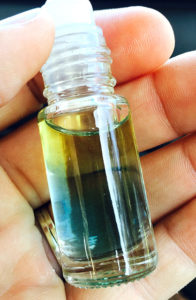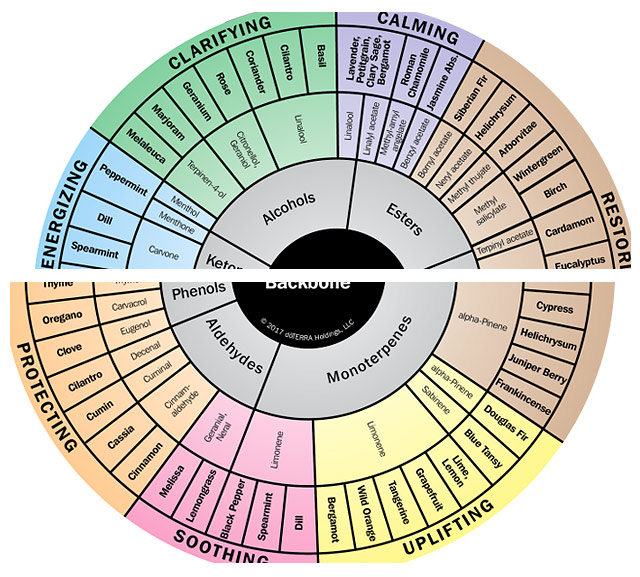Imagine A Smell Activating Your Comfort
Essential Oil and Aroma Therapy 101 – Part 1 & 2
By Diane C. Sallade, MSEd, LPC

Centuries Old Aroma Therapy
Although the term aromatherapy and the popularity of essential oils may appear to be a fad or recent trend, the use of aromatic plant extracts and essential oils is centuries old. Ancient civilizations frequently used essentials oils during rituals, religious ceremonies, and burials, recognizing the power of these oils on emotions. Babylonians and Assyrians burned Frankincense during religious ceremonies due to its warm aroma that promotes feelings of peace and relaxation. The soldiers of ancient Rome used Fennel before going into battle to help them feel strong and courageous.
Today, science helps us understand that essential oils are not just a pleasant scent, but have physical compounds that communicate with the chemistry of our endocrine and nervous systems. Each essential oil has a unique chemical profile of often dozens of different compounds that determine its attributes, benefits, and the emotional response it can produce.
Find Your Smell
It is possible to choose an essential oil to elicit a specific emotional response based on the chemical compounds it contains. For example, the compound linalool is known for its calming properties and ability to soothe the nervous system. For someone who struggles with anxiety, using an essential oil that contains linalool such as Basil, Marjoram, Lavender, Ylang Ylang, Clary Sage, or Jasmine can be beneficial for easing their symptoms.
In most cases, an essential oil can be categorized as having either a calming or uplifting effect due to its chemical makeup.
 Essential Oil Constituent Qualities:
Essential Oil Constituent Qualities:
- Mint: Commonly known to be uplifting and energizing due to a high concentration of ketones
- Floral: Typically contain monoterpene which provide calming properties
- Tree, herb, and grass: Primarily include sesquiterpenes, oxides, and esters which help promote grounding emotions and feelings of renewal
- Citrus: Contain chemical components like beta-pinene, monoterpenes, and limonene which have significant uplifting characteristics
- Spice: Provide warming qualities due to containing phenols
If you would like to learn more about essential oils and their role in therapy, please contact New Directions Counseling at 724.934.3905 to set up an appointment.
Questions? Schedule An Appt? Call Today 724.934.3905
Questions? Schedule An Appt? Call Today 724.934.3905
Effective Essential Oil Uses
A brief guide on aroma, topical and internal usage
By Diane C. Sallade, MSEd, LPC
There are three basic methods for your essential oil use: aromatically, topically, and internally, with aromatic use having the most immediate effect.
Taken in part from DoTerra Oil Wheel
Aromatic Approach
As volatile aromatic compounds, essential oils can disperse through the air quickly. This allows you to experience the aroma just from opening the bottle. A simple, quick way to use essential oils aromatically is to put one or two drops in the palm of your hand and rub your hands together. Then cup your hands over your nose and inhale. The use of an essential oil diffuser allows for more prolonged aromatic use. Most diffusers transform the oil which has been dropped into water, into a mist of microscopic oil droplets, dispersing the oil and its aroma into the air.
Essential Aromatic Tip: An easy, portable diffuser can be a cotton ball or pad with several drops of oil that one can carry with them.
Topical Treatment
Topical use of essential oils is the direct application of an oil to the skin or body. Safe topical use often involves diluting the essential oil with a carrier oil. By diluting an essential oil, you slow the rate of evaporation, enhance absorption into the skin, and protect sensitive or delicate skin. Common carrier oils include coconut oil or fractionated coconut oil (liquefied), avocado oil, sweet almond oil, and olive oil. Common areas of application when using an essential oil for its emotional effects are the back of the neck, the temples, insides of the wrists. Also consider the bottom of the feet and particularly the big toes!
Essential Topical Tip: A recommended dilution ratio is 3 drops of carrier oil for 1 drop of essential oil. Pure essential oils are very potent and a small amount goes a long way.
- First Time Topical Advice > When applying an essential oil for the first time, it is a good idea to conduct a sensitivity test to see how your body and skin react to the chemical structure of the oil. Apply the diluted oil to an inconspicuous area of the skin. Then check the area each hour for several hours to make sure there is no sensitivity or irritation. After applying essential oils topically, it is a good idea to wash your hands with soap and water, and avoid rubbing or touching your face or eyes. It is important to note that due to photosensitive compounds, some essential oils, particularly citrus oils, can cause sensitivity when exposed to sun or ultraviolet light after topical application. It is recommended that one avoid exposure to sunlight, UV light, or sunlamps for up to 12 hours after application. Essential oils that pose a risk for photo sensitivity typically include a warning or caution on the bottle or packaging.
Ingestion Ideas
While we ingest small amounts of essential oils naturally occurring in our food and drink, internal use of potent and powerful bottled essential oils involves many considerations. Some oils should never be used internally due to their chemical makeup. More importantly, not all brands of oils are the same due to harvest and production, and testing can vary among distributors. While some oils are pure and thoroughly tested, others include fillers, preservatives, or impurities that lower the quality of the oil and make it unsafe for internal use.
Ingestion Oil Tip: When choosing your essential oils, be sure to choose a company that has thoroughly tested their oils for purity and can guarantee that they do not contain any synthetic compounds.
Regardless of your essential oil uses, an important consideration for receiving the therapeutic benefits, is the purity and ratios of its various compounds. There are no industry standards and recent research shows that approximately 80% of essential oils on the market have been either adulterated or contaminated in some way. Contamination can be from pesticides or distillation substances such as solvents. Adulteration includes intentional dilution and fabrication of an oil or any of its components.
Today’s laboratories can synthetically make almost every compound in an essential oil, allowing for the production of synthetic essential oils that are significantly less expensive. However, these synthetic compounds do not have the same effect on the body and will often create more problems and issues than benefits. Detecting the presence of contaminants and adulterants is time consuming and expensive, and not all distributors perform the testing necessary to determine the quality of their oils.
If you are interested in learning more about essential oil uses for your lifestyle and mood, please call New Directions Counseling at 724.934.3905. Our expert therapists have the experience and empathy needed for you to make the change last.
Did you read part 1: Essential Oils 101?

 Essential Oil Constituent Qualities:
Essential Oil Constituent Qualities: